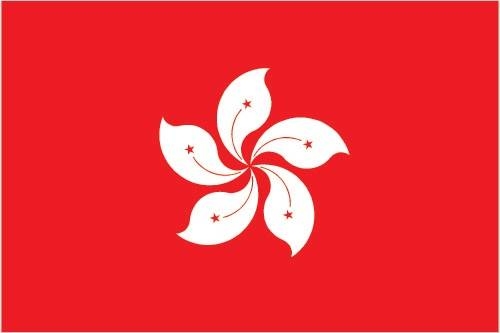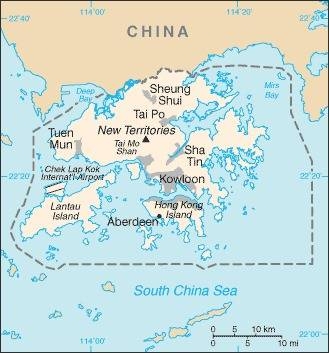135 Hong Kong (China)

Red with a stylized, white, five-petal Bauhinia flower in the center. Each petal contains a small, red, five-pointed star in its middle. The red color is the same as that on the Chinese flag and represents the motherland. The fragrant Bauhinia – developed in Hong Kong the late 19th century – has come to symbolize the region. The five stars echo those on the flag of China.
Flag courtesy of the CIA World Factbook

Map courtesy of the CIA World Factbook

A nighttime view of part Hong Kong viewed from Victoria Peak. Hong Kong has the largest number of skyscrapers of any city in the world (482 as of January 2021; a skyscraper is defined as a continuously-habitable building that has more than 40 floors and is taller than approximately 150 m (492 ft)). By comparison, third-ranking New York City “only” has 290 skyscrapers.
Photo courtesy of the CIA World Factbook
Last updated on March 21, 2025
Government
According to Britannica, when it was a colony, Hong Kong was administered by a governor, who was appointed by and represented the monarch of the United Kingdom, directed the government, served as the commander in chief, and presided over the two main organs of government, the Executive Council and the Legislative Council. With the resumption of Chinese sovereignty over the territory in July 1997, the Basic Law of the Hong Kong Special Administrative Region (promulgated by the National People’s Congress of China in 1990) went into effect. The guiding principle of the Basic Law was the concept of “one country, two systems,” under which Hong Kong was allowed to maintain its capitalist economy and to retain a large degree of political autonomy (except in matters of foreign policy and defense) for a period of 50 years. A controversial security law passed by the mainland government and imposed on Hong Kong in 2020, however, had the ability to weaken the concept of “one country, two systems” and threatened the political autonomy that the region had enjoyed.
The Basic Law vests executive authority in a chief executive, who is under the jurisdiction of the central government in Beijing and serves a five-year term. Legislative authority rests with a Legislative Council (LegCo), whose 70 members (increased from 60 for the 2012 legislative elections) serve a four-year term; the chief executive, however, can dissolve the council before the end of a term.
According to the Basic Law, the chief executive for the second term was appointed by the central government, following election by an 800-member Election Committee in Hong Kong. The constituencies for LegCo members were then defined during their second and third terms, and by the third term half had been directly elected from geographic constituencies and half had been selected from “functional constituencies” drawn from business and professional circles. The Basic Law further states, however, that the chief executive and council members ultimately were to be elected by universal suffrage. Those electoral procedures were to have been determined by 2007, but in that year the Standing Committee of the National People’s Congress in Beijing ruled that universal suffrage would not be implemented before 2012. A 1,200-member Election Committee chose a new chief executive in 2012, but by then Beijing had indicated that direct election for that office may be permitted in 2017. However, that never came to pass, leading to widespread concern among pro-democracy Hong Kong citizens that true universal suffrage would never be implemented.
Civil Aviation Department (CAD)
Established in 1946, the Civil Aviation Department (CAD) is headed by the Director-General of Civil Aviation (DGCA). The DGCA oversees the operation of the following 7 Divisions:
- Flight Standards and Airworthiness Division headed by the Assistant Director-General (Flight Standards);
- Air Traffic Management Division headed by the Assistant Director-General (Air Traffic Management);
- Air Traffic Engineering Services Division headed by the Assistant Director-General (Air Traffic Engineering Services); and
- Airport Standards Division headed by the Assistant Director-General (Airport Standards).
- Air Services and Safety Management Division headed by the Assistant Director-General (Air Services and Safety Management);
- Administration Division headed by the Departmental Secretary; and
- Finance Division headed by the Chief Treasury Accountant.
Airspace
SkyVector – Google Maps – ADS-B Exchange
ICAO countries publish an Aeronautical Information Publication (AIP). This document is divided into three parts: General (GEN), En Route (ENR) and Aerodromes (AD). ENR 1.4 details the types of airspace classes they chose to adopt from classes A through G.
Drone Regulations
Small Unmanned Aircraft Order (Cap.448G)
Features Drone Map and Tips for Visitors
Advanced Air Mobility (AAM) Regulations & Policies
None found by the author.
However, should you, the reader, happen to stumble across something to the contrary, please email the author at FISHE5CA@erau.edu and you may be mentioned in the ACKNOWLEDGEMENTS section of this book by way of thanks for contributing to this free eBook!
Advanced Air Mobility (AAM) News
None found by the author.
However, should you, the reader, happen to stumble across something to the contrary, please email the author at FISHE5CA@erau.edu and you may be mentioned in the ACKNOWLEDGEMENTS section of this book by way of thanks for contributing to this free eBook!
Short Essay Questions
Scenario-Based Question
You have been hired by a Drone Startup Company. Your boss has immediately assigned this job to you.
They need you to prepare a one-page memo detailing the legalities of using a drone to film at night in Hong Kong, pictured above.
They need you to mention any national laws and local ordinances.
They specifically want to know what airspace (insert pictures) you will be operating in and whether or not you need an airspace authorization.
Does it matter whether or not you are a citizen of the country?
Lastly, there is a bonus for you if, as you scroll through this chapter, you find any typos or broken links!
Short Essay Questions
- What are the drone categories?
- How is registration addressed?
- How is remote ID addressed?
- What are the model aircraft rules?
- What are the commercial drone rules?
- Are there waivers or exemptions to the rules? If so, for what?
- Would you share a link to an interactive airspace map?
- How is BVLOS addressed?
- How can you fly drones at night?
- How can you fly drones over people?
- Where do you find drone NOTAMs?
- What are the rules for drone maintenance?
- What are the rules for an SMS program?
- What are some unique rules not mentioned above?
- What are the C-UAS rules?
- What are the AAM rules?

